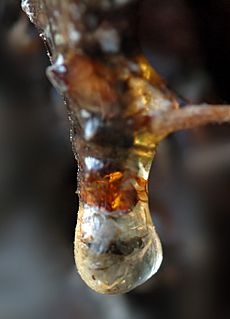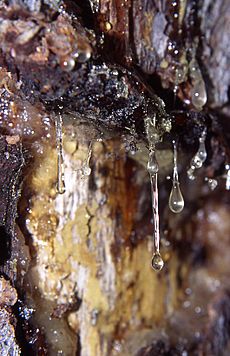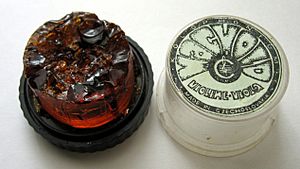Resin facts for kids
Resin is a sticky, natural substance that many plants make. It's like a special sap, especially common in coniferous trees like pines. Plants create resin as a way to protect themselves.
Plants have developed many complex chemicals over time. These chemicals help them defend against animals that might try to eat them. Resin is one of these defenses. Plants release resin when they get hurt, like from a cut or an insect bite.
This sticky resin acts like a shield. It protects the plant from tiny insects and germs that could cause disease. The resin can trap insects or make them sick. It also has special smells that might attract helpful insects, like those that hunt plant-eating pests.
People have found many uses for resins. They are used to make varnishes, which protect wood, and adhesives, which are glues. Resins are also used to create incense and perfumes because of their unique scents. Very old, fossilized resin turns into amber, a beautiful gemstone. There are also man-made substances called synthetic resins that have similar uses.
Resins are made of tiny parts called atoms, mainly carbon and hydrogen. They also have small amounts of oxygen, nitrogen, and sulfur. Synthetic resins are used in many products, like strong layers for floors or glues.
What is Rosin?
Rosin is a solid form of resin. It's also known as 'colophony' or 'Greek pitch'. We get rosin mostly from pine trees and other conifers. To make rosin, the fresh, liquid resin is heated. This process makes the lighter, more liquid parts evaporate, leaving behind the solid rosin.
Rosin can be yellow to black and is usually see-through. The name "colophony" comes from an old city called Colophon. This city was known for its pine trees and the resin they produced.
How We Use Rosin
Rosin has many different uses in our daily lives. Here are some of the main ways people use it:
- Stopping slips: Rosin helps things grip better. Musicians use it on their violin bows so the bow can grab the strings and make sound. Dancers use it on their shoes, and gymnasts use it on their hands to prevent slipping. Rock climbers also use it for better grip.
- Making products: Rosin is an ingredient in many things we use. It's found in soap, inks, some paints, paper, varnish, glue, and even sealing wax. It's also used in special mixtures for soldering, which is used to join metal parts.
- Medicine: Rosin is used in some medicines. It can help make the coating for tablets or be part of tiny capsules that deliver medicine in the body.
- Natural forms: Copal and amber are natural forms of rosin. They are created when the lighter parts of tree resin evaporate over a very long time, leaving behind a hard, fossilized rosin.
Images for kids
-
A Cedar of Lebanon cone showing small bits of resin. Resin was used in the mummification of ancient Egyptian Pharaohs.
-
The sticky substance on this almond tree looks like resin, but it's actually a gum or mucilage, which is chemically different.
-
Dried lumps of frankincense resin, often used for its scent.
See also
 In Spanish: Resina para niños
In Spanish: Resina para niños









